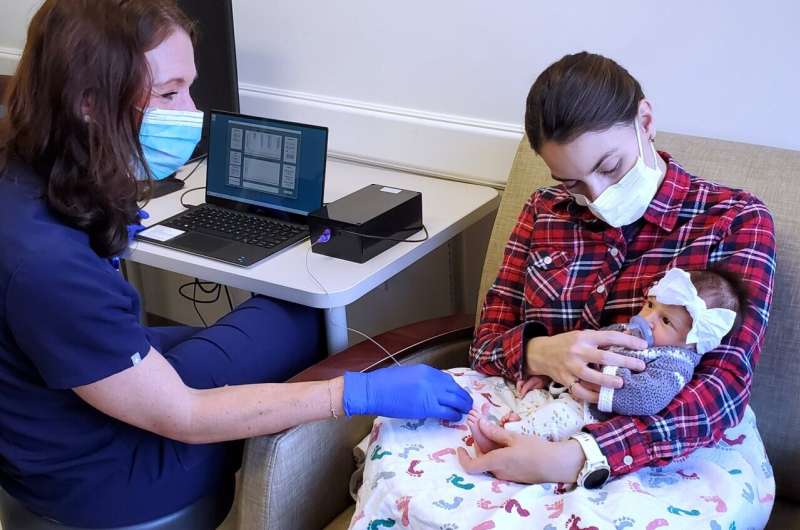This article has been reviewed according to Science X's editorial process and policies. Editors have highlighted the following attributes while ensuring the content's credibility:
fact-checked
trusted source
proofread
AI algorithms can determine how well newborns nurse, study shows

A modified pacifier and AI algorithms to analyze the data it produces could determine if newborns are learning the proper mechanics of nursing, a recent study shows.
Specifically, the researchers from the University of California San Diego measured if babies are generating enough suckling strength to breastfeed and whether they are suckling in a regular pattern based on eight independent parameters.
The results, published in the April 18 online edition of IEEE Journal of Translational Engineering in Health and Medicine, give researchers objective data that shows standard assessments can be improved and could potentially prevent surgical interventions.
Currently, to determine if an infant is feeding properly, clinicians rely on two measures. One is objective: is the baby gaining enough weight? The other is more subjective: clinicians put a finger in the baby's mouth and evaluate how well the baby is sucking on that finger.
"The method we developed with our clinical partners replaces this subjective assessment with objective data," said James Friend, a professor in the Department of Mechanical and Aerospace Engineering and the Department of Surgery at UC San Diego and one of the paper's senior authors.
The testing method has two components. One is a device made up of a simple pacifier, connected to a 36-inch-long tube connected in turn to a vacuum sensor and a chip that collects the data from the sensor. The device can connect to any laptop.
"We wanted to keep the technology as simple as possible with off-the-shelf, cost-effective components to facilitate adoption in the clinic," said Friend, who is a faculty member at the UC San Diego Jacobs School of Engineering.
The second component is software that both displays the data and uses machine learning algorithms to identify abnormalities and outliers. The software records data as an infant sucks on the pacifier and compares that data with information from other infants. Two different machine learning algorithms analyze the data and flag abnormal patterns if they are present.
Prior studies have shown that non-nutritive suckling on a pacifier produces data that can be used to evaluate breastfeeding.
"It's reassuring for me to rely on scientific data to back up my assessments," said co-senior author of the study, Erin Walsh, a speech-language pathologist and lactation consultant at UC San Diego Health. "We hope our findings help support parents struggling to breastfeed and improve long-term health outcomes."
The study's findings mostly validated clinician conclusions. But the study also showed that subjective evaluation of infants' suckling ability by a clinician inserting their fingertip into the infants' mouth, which is currently standard practice, could be improved by data the device generates.
"Early detection of breastfeeding difficulties within the first month is critical, as it coincides with the important phase of milk establishment and susceptibility to breast injury," said Phuong Truong, the paper's first author and a Ph.D. student in Friend's lab.
Although mothers can receive medical assistance, the absence of precise measurement tools means that identifying underlying issues can take longer, potentially contributing to a decline in breastfeeding rates, she said.
"Our measurement system aims to offer rapid and precise data on an infant's suckling ability early on, empowering clinicians to address root causes quickly and potentially mitigate breastfeeding attrition," Truong said.
Is tongue-tie surgery needed?
An estimated 7% of babies are diagnosed with a condition called tongue-tie, in which the connection between the tongue and the floor of the mouth is too strong and limits tongue movement. The condition presents challenges with breastfeeding and often requires surgery, known as a frenotomy, where the connective tissue between the tongue and the floor of the mouth are cut.
Data from the device showed there was not a change pre and post-surgery for half of the infants examined who had undergone a frenotomy. The other half, whose data patterns were abnormal, and whom the algorithms identified as needing a frenotomy, did benefit from the operation with much improved suckling behavior after the surgery.
These results suggest that, in some cases, surgical interventions could potentially be prevented.
Data from the device also flagged abnormal nursing behavior in five babies, which had not been found during a clinical exam.
These findings are important because frenotomies have had a tenfold increase in less than a decade. "Our data show that frenotomies are not a blanket solution for breastfeeding difficulties," Walsh added.
How the study was conducted
The proof of concept study was approved by UC San Diego's Internal Review Board. Parents of healthy full-term infants under 30 days old were recruited from the UC San Diego Center for Voice and Swallowing, UC San Diego Health La Jolla Pediatrics, and the UC San Diego Jacobs Medical Center.
In all, the 91 participants in the proof of concept study were recruited during routine postpartum care with their general pediatrician at UC San Diego Health or while consulting with feeding specialists at their respective locations. Infant inclusion criteria included full-term healthy infants establishing breastfeeding and without significant birth or postpartum complications.
Clinicians were blinded to device data in this study and performed evaluations solely based on standard practice. After clinical assessments, parents were provided the opportunity to introduce the modified pacifier for a 60 second measurement of their infant's intraoral suckling vacuum.
Next steps include conducting a clinical trial outside of UC San Diego Health with the ultimate goal of making both the device and algorithm widely available in pediatric practices, where they could be used during an infant's first visit.
More information: Phuong Truong et al, Application of Statistical Analysis and Machine Learning to Identify Infants' Abnormal Suckling Behavior, IEEE Journal of Translational Engineering in Health and Medicine (2024). DOI: 10.1109/JTEHM.2024.3390589




















